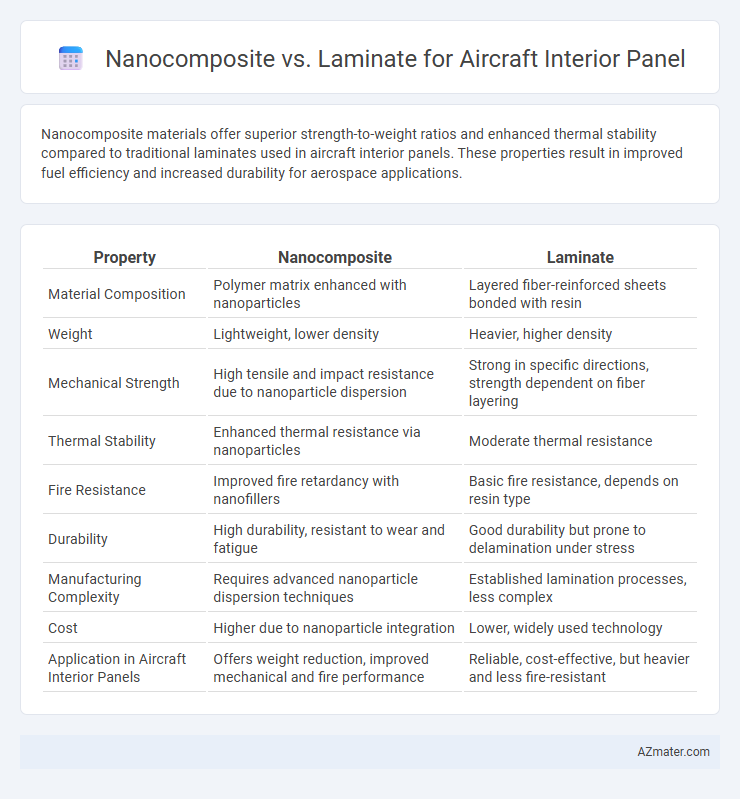Nanocomposite materials offer superior strength-to-weight ratios and enhanced thermal stability compared to traditional laminates used in aircraft interior panels. These properties result in improved fuel efficiency and increased durability for aerospace applications.
Table of Comparison
| Property | Nanocomposite | Laminate |
|---|---|---|
| Material Composition | Polymer matrix enhanced with nanoparticles | Layered fiber-reinforced sheets bonded with resin |
| Weight | Lightweight, lower density | Heavier, higher density |
| Mechanical Strength | High tensile and impact resistance due to nanoparticle dispersion | Strong in specific directions, strength dependent on fiber layering |
| Thermal Stability | Enhanced thermal resistance via nanoparticles | Moderate thermal resistance |
| Fire Resistance | Improved fire retardancy with nanofillers | Basic fire resistance, depends on resin type |
| Durability | High durability, resistant to wear and fatigue | Good durability but prone to delamination under stress |
| Manufacturing Complexity | Requires advanced nanoparticle dispersion techniques | Established lamination processes, less complex |
| Cost | Higher due to nanoparticle integration | Lower, widely used technology |
| Application in Aircraft Interior Panels | Offers weight reduction, improved mechanical and fire performance | Reliable, cost-effective, but heavier and less fire-resistant |
Introduction to Aircraft Interior Panels
Aircraft interior panels utilize advanced materials to enhance safety, durability, and weight reduction. Nanocomposites incorporate nanoscale fillers that improve mechanical strength, thermal stability, and fire resistance, making them ideal for modern aircraft interiors. In contrast, traditional laminates consist of stacked layers bonded together, offering proven rigidity and ease of fabrication but often at a higher weight and lower performance compared to nanocomposites.
Overview of Nanocomposite Materials
Nanocomposite materials for aircraft interior panels combine nanoscale fillers such as carbon nanotubes or nanoclays with polymer matrices to enhance mechanical strength, thermal stability, and flame retardancy compared to traditional laminate composites. These nanofillers improve impact resistance and reduce weight, contributing to increased fuel efficiency and safety in aerospace applications. Advanced nanocomposites also exhibit superior barrier properties and reduced outgassing, meeting stringent aviation industry standards for interior cabin components.
Understanding Laminate Materials
Laminate materials in aircraft interior panels consist of multiple layers bonded together, typically combining decorative surfaces with structural cores such as honeycomb or foam to achieve strength and lightweight properties. These laminates provide enhanced fire resistance, durability, and aesthetic customization, meeting stringent aerospace standards like FAR 25.853 for flammability. Compared to nanocomposites, laminates offer predictable mechanical behavior and established certification pathways, making them a reliable choice for interior panel construction.
Key Performance Criteria in Aircraft Panels
Nanocomposite aircraft interior panels exhibit superior impact resistance, enhanced thermal stability, and significant weight reduction compared to traditional laminate panels. Laminate panels, while cost-effective and easy to manufacture, often fall short in flame retardancy and mechanical strength under extreme conditions. The integration of nanomaterials in nanocomposites leads to improved stiffness-to-weight ratios and better acoustic insulation, essential for modern aircraft cabin performance.
Weight Reduction: Nanocomposites vs Laminates
Nanocomposites offer significant weight reduction compared to traditional laminates in aircraft interior panels due to their superior strength-to-weight ratio and enhanced material properties at the nanoscale. The integration of nanoparticles such as carbon nanotubes or graphene within polymer matrices results in lighter panels without compromising structural integrity or fire resistance. This weight reduction translates directly into improved fuel efficiency and lower operational costs for aircraft operators.
Fire Resistance and Safety Standards
Nanocomposite materials in aircraft interior panels offer enhanced fire resistance due to their nanoscale fillers, which improve thermal stability and reduce flammability compared to traditional laminates. These materials comply with stringent aviation safety standards such as FAR 25.853, ensuring limited smoke density and toxic gas emissions during fire exposure. Laminate panels, while commonly used for structural rigidity, often require additional fire-retardant treatments to meet the same safety regulations, making nanocomposites a more advanced solution for fire safety in modern aircraft interiors.
Durability and Mechanical Properties Comparison
Nanocomposite materials offer superior durability and enhanced mechanical properties compared to traditional laminates in aircraft interior panels. Their nanoscale reinforcements improve impact resistance, tensile strength, and fatigue life while reducing weight, which is critical for aerospace applications. Laminates, although reliable, typically exhibit lower resistance to delamination and mechanical degradation under cyclic loading compared to advanced nanocomposite structures.
Cost Analysis and Manufacturing Complexity
Nanocomposite materials for aircraft interior panels offer cost advantages due to reduced material weight and potential for automation in manufacturing, resulting in lower labor expenses compared to traditional laminate composites. However, nanocomposites often require advanced processing techniques, including precise nanoparticle dispersion and specialized curing cycles, which increase manufacturing complexity and initial setup costs. In contrast, laminates benefit from established production methods with predictable costs but may incur higher material consumption and longer cycle times, impacting overall cost efficiency.
Sustainability and Environmental Impact
Nanocomposite materials in aircraft interior panels offer enhanced sustainability through reduced weight and improved fuel efficiency, resulting in lower carbon emissions during flight operations. These materials typically incorporate bio-based or recyclable components, minimizing environmental impact compared to traditional laminate panels, which often rely on non-recyclable resins and heavier substrates. The durability and longevity of nanocomposites contribute to longer service life and reduced waste generation, reinforcing their environmental advantages over conventional laminates in aerospace applications.
Future Trends in Aircraft Interior Panel Materials
Nanocomposite materials offer enhanced mechanical strength, reduced weight, and improved fire resistance compared to traditional laminate panels, making them ideal for next-generation aircraft interiors. Emerging trends focus on integrating multifunctional nanomaterials that provide enhanced electromagnetic shielding, self-healing properties, and sustainable recyclability. Advanced manufacturing techniques like additive manufacturing are accelerating the adoption of nanocomposites to meet future demands for lightweight, durable, and eco-friendly aircraft interior panels.

Infographic: Nanocomposite vs Laminate for Aircraft interior panel
 azmater.com
azmater.com